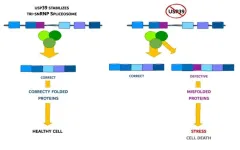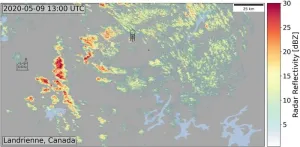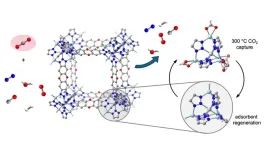Answer ALS releases world's largest ALS patient-based iPSC and bio data repository
Unprecedented resource, created with Cedars-Sinai, to accelerate ALS research and drive development of targeted therapies globally
2024-11-14
(Press-News.org)
Answer ALS Releases World's Largest ALS Patient-Based iPSC and Bio Data Repository
Unprecedented resource, created with Cedars-Sinai, to accelerate ALS research and drive development of targeted therapies globally
NEW ORLEANS, [November 14, 2024] — In a landmark continuing collaboration, Answer ALS and Cedars-Sinai have announced the completed availability of the largest amyotrophic lateral sclerosis (ALS) patient-based induced pluripotent stem cell (iPSC) and bio data repository. The repository encompasses biological and clinical data from nearly 1,000 ALS patients, offering an unprecedented resource for global researchers studying ALS, commonly known as Lou Gehrig's disease.
Led by Dhruv Sareen, Ph.D., Executive Director of the Cedars-Sinai Biomanufacturing Center, the team, which includes Biomanufacturing Center Manager Loren Ornelas and Associate Biomedical Scientist Aaron Frank, has achieved a milestone in ALS research. “We reprogrammed blood cells into iPSCs and differentiated them into motor neurons, which die in ALS patients at an unprecedented scale,” Sareen said. “This has established the world’s largest bank of specialized neurons for ALS research to date and offers a comprehensive and advanced model for disease research and drug discovery.”
This approach enables investigators across academia and industry to access a vast array of patient-specific iPSCs and differentiated motor neurons. They can then analyze ALS disease progression in lab-created cells and correlate these observations with the detailed clinical, genetic, and protein profiles unique to each ALS patient.
The availability of an ALS patient’s “avatar-in-a-dish” with an extensive selection of multi-omics data is critical for understanding the unique characteristics of ALS in individuals, paving the way for tailored therapeutic strategies. Unlike mouse models, patient-specific iPSCs embody the full complexity of human biology—including genetic, epigenetic, transcriptomic, and proteomic profiles—offering a more comprehensive and precise means to study disease mechanisms and evaluate potential treatments. This represents a pivotal advancement in ALS research, significantly enhancing our ability to address this challenging and devastating disease.
These data and links to the associated bio-resources (tools, patient-derived biofluids, iPSC lines) are made available to the global research community through the Answer ALS Neuromine Data Portal, and Cedars-Sinai Biomanufacturing Center, which serves as a crucial tool for researchers, offering access to a wide array of patient-specific iPSCs and the data inherent in these cells. The availability of detailed genomic data is imperative for understanding the unique characteristics of the disease in individuals, paving the way for tailored therapeutic strategies.
"ALS remains one of the most challenging neurological diseases, with no cure and limited treatment options. Creating high-quality ALS iPSC lines and generating neurons from them at this scale is unprecedented," said Clive Svendsen, Director of the Board of Governors Regenerative Medicine Institute at Cedars-Sinai. “We believe this comprehensive platform will serve as a critical resource for the scientific community, propelling research into ALS pathogenesis, therapeutic development, and precision medicine approaches. The availability of this biorepository and the integration of a rich multi-omics dataset allows investigation of complex biological networks that drive ALS. We are offering these essential patient cells to the entire research community via the Cedars-Sinai Biomanufacturing Center biorepository as part of the Neuromine data portal resources."
The repository has already distributed over 1,800 cell lines to over 130 entities, including universities and pharmaceutical companies both domestically and internationally. By making the Answer ALS data continuously available through an online, open-source portal, the repository ensures that the data from every sample is accessible to scientists worldwide, enhancing the collective effort to decipher ALS pathology and develop targeted therapies.
"This model has never existed before at this scale; it surpasses traditional methods and has the potential to dramatically accelerate the pace of ALS research," said Clare Durrett, Managing Director of Answer ALS. "By making these high-quality, patient-specific iPSCs available to the scientific community, we are directly supporting the urgent efforts to develop effective treatments for individuals and families affected by ALS, where every second counts in the fight against this disease."
The repository represents a quantum leap over existing models, also providing ready-to-investigate motor neurons in just 7-10 days—compared to the approximately 45 days typically required to generate motor neurons from iPSCs—and offering efficiency that is crucial for fast-tracking the development of effective ALS treatments. With this largest-ever repository of patient-derived iPSCs and motor neurons for ALS research, complemented by a rich multi-omics dataset, the transformative potential of this platform will empower expanded collaborations with international research and biotech communities.
For more information about accessing the data and collaborating with the Answer ALS and Cedars-Sinai team, please contact Clare Durrett at clare@answerals.org.
About Answer ALS
Answer ALS is the most comprehensive ALS research consortium in history, producing more ALS data and biological samples than has ever been amassed, while openly sharing with the global research community. These data and samples are used to investigate the unique pathways of each variation of ALS and begin to develop and test the right treatments or cure. Answer ALS is an unprecedented approach to understanding and defeating the disease.
Headquartered in New Orleans and Washington, D.C., Answer ALS stands at the forefront of global efforts to eradicate the disease, supported by research partners and advocates worldwide.
For more information, visit us at answerals.org, LinkedIn, X, Facebook and Instagram.
Media Contacts:
Kissy Black
Answer ALS
kblack@answerals.org
Roxan Triolo Olivas
Lotos Nile
roxan@lotosnile.com
END
[Attachments] See images for this press release:
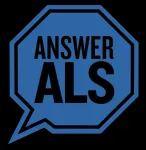
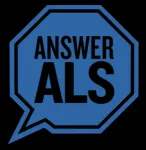
ELSE PRESS RELEASES FROM THIS DATE:
2024-11-14
WASHINGTON, Nov. 14, 2024 – AIP and the National Society of Black Physicists congratulate Danielle Speller as the winner of the 2024 Joseph A. Johnson Award for Excellence. Jessica Esquivel is also being recognized with an Honorable Mention.
The Johnson Award, now in its fifth year, is given jointly by AIP and NSBP to recognize early-career scientists who demonstrate scientific ingenuity and impactful mentorship and service—the core values of NSBP founder Joseph A. Johnson.
“Dr. Speller not only ...
2024-11-14
FRANKFURT. Genes contain the essential building instructions for life, guiding cells on which amino acids to assemble in what sequence to produce specific proteins. The human genome codes for about 20,000 such instructions. “Nevertheless, our cells can produce several hundred thousand different proteins,” explains Prof. Ivan Đikić from the Institute of Biochemistry II at Goethe University Frankfurt.
This diversity is enabled by a process known as “splicing.” When a cell requires a protein, it generates a copy of the relevant instructions in the cell nucleus. During splicing, this transcript undergoes modification: a cellular editing complex, the spliceosome, ...
2024-11-14
Pollution from industrial hotspots can trigger ice formation in supercooled clouds, altering their reflective properties and increasing regional snowfall, according to a new study. The findings shed light on poorly understood impacts of anthropogenic aerosols on climate and could help improve climate modeling and mitigation strategies. The impact of human-generated aerosols (tiny air pollution particles) on climate, particularly in counteracting greenhouse gas-induced warming, remains uncertain. These aerosols, in addition to influencing cloud formation as cloud condensation nuclei (CCN), may also act as ice-nucleating particles (INPs), crucial for ice formation in supercooled ...
2024-11-14
In a Policy Forum, Chad Nelson and colleagues highlight the efforts of the U.S. Food and Drug Administration (FDA) in advancing alternative methods to reduce animal testing for regulatory use. Animal studies have been crucial for advancing disease understanding, developing therapies, and assessing the safety and effectiveness of consumer products. However, reducing animal use and developing effective alternatives is an ongoing priority. Although advances in biology, engineering, and artificial intelligence offer new opportunities to improve product safety assessments, these technologies require extensive development to meet regulatory ...
2024-11-14
A new study presents “Evo” – a machine learning model capable of decoding and designing DNA, RNA, and protein sequences, from molecular to genome scale, with unparalleled accuracy. Evo’s ability to predict, generate, and engineer entire genomic sequences could change the way synthetic biology is done. “The ability to predict the effects of mutations across all layers of regulation in the cell and to design DNA sequences to manipulate cell function would have tremendous diagnostic and therapeutic implications for disease,” writes Christina Theodoris ...
2024-11-14
Without intervention, global plastic waste could double by 2050, a new machine learning study predicts. However, according to simulations by the study’s authors, a mix of policy interventions could cut plastic waste by more than 90% and it could cut plastics-related emissions by a third. With UN treaty negotiations underway, these findings provide a crucial blueprint for tackling the plastic crisis. Plastic production has increased relentlessly for decades, leading to surging plastic waste generation and environmental mismanagement. As plastic ...
2024-11-14
Anthropogenic aerosols, tiny solid and liquid air pollution particles, have masked a fraction of global warming caused by anthropogenic greenhouse gases. Climate researchers have known for decades that anthropogenic aerosols perturb liquid clouds by enabling the formation of a larger number of cloud droplets, making clouds brighter. A new landmark study led by the University of Tartu suggests that anthropogenic aerosols may also influence clouds by converting cloud droplets to ice at temperatures below zero degrees Celsius.
Powerplant Snow
Using satellite observations, climate researchers discovered unique plumes of ice clouds and reduced cloud cover downwind of industrial hot spots ...
2024-11-14
Scientists have found a trigger for social learning in wild animals. An experiment on great tits has pinpointed a single factor—immigration—that can cause birds to pay close attention to others, leading them to rapidly adopt useful behaviors. The study is the first to provide experimental support of a long-held assumption that immigrants should strategically use social learning. The study, conducted by scientists from the Max Planck Institute of Animal Behavior (MPI-AB) and the Cluster of Excellence Collective Behaviour at the University of Konstanz in Germany, is published November 14 in PLOS Biology.
Many animals that live in groups learn from one another, but few ...
2024-11-14
Berkeley, CA/Santa Barabara, CA (14 November 2024) — A new study released in Science today determines that just four policies can reduce mismanaged plastic waste — plastic that isn’t recycled or properly disposed of and ends up as pollution — by 91% and plastic-related greenhouse gasses by one-third. The policies are: mandate new products be made with 40% post-consumer recycled plastic; cap new plastic production at 2020 levels; invest significantly in plastic waste management — such as landfills and waste collection services; and implement a small fee on plastic packaging. ...
2024-11-14
Industrial plants, such as those that make cement or steel, emit copious amounts of carbon dioxide, a potent greenhouse gas, but the exhaust is too hot for state-of-the-art carbon removal technology. Lots of energy and water are needed to cool the exhaust streams, a requirement that has limited adoption of CO2 capture in some of the most polluting industries.
Now, chemists at the University of California, Berkeley, have discovered that a porous material can act like a sponge to capture CO2 at temperatures close to those of many industrial exhaust streams. ...
LAST 30 PRESS RELEASES:
[Press-News.org] Answer ALS releases world's largest ALS patient-based iPSC and bio data repository
Unprecedented resource, created with Cedars-Sinai, to accelerate ALS research and drive development of targeted therapies globally



